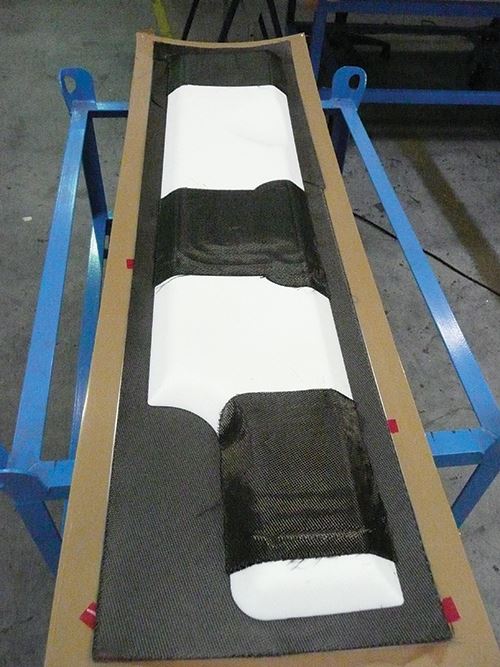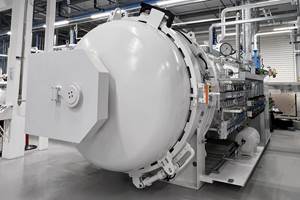PMI foam core outperforms honeycomb in infused nose landing gear doors
The results of Airbus (Toulouse, France) subsidiary Composite Technology Centre GmbH (CTC, Stade, Germany) studies in 2013 to find more productive but less costly methods of fabricating carbon fiber-reinforced polymer (CFRP) sandwich constructions.
Composite Technology Centre GmbH (CTC, Stade, Germany) specializes in developing cost-effective serial-production composite technologies. A subsidiary of Airbus (Toulouse, France), CTC undertook studies in 2013 to find more productive but less costly methods of fabricating carbon fiber-reinforced polymer (CFRP) sandwich constructions. Evonik Foams Inc. - ROHACELL (Darmstadt, Germany) submitted samples of its new ROHACELL HERO polymethacrylimide (PMI) closed-cell foam to CTC for evaluation as a core-material alternative to traditional honeycomb. The new PMI foam is the fruit of an unusual Evonik effort to develop a new polymethacrylimide (PMI) foam product that can mimic honeycomb core’s tendency to show visible laminate damage. Although foam is touted as a means to prevent water-ingress into surface-damaged aircraft parts, PMI foam’s greatest asset in other applications — its superior impact resistance compared to honeycomb core products — makes it difficult for aircraft maintenance and repair organizations (MROs) to visually identify damage on aircraft sandwich constructions during part inspections. Evonik’s HERO product is specifically formulated to accommodate this need in PMI foam performance properties.
CTC evaluated three CFRP sandwich construction design options: (1) autoclaved, honeycomb-cored, carbon/epoxy prepreg; (2) autoclaved PMI-cored, carbon/epoxy prepreg; and (3) an out-of-autoclave (OOA) alternative featuring PMI core between faceskins of carbon fiber infused with liquid epoxy resin. Options 2 and 3 required significantly less time and cost than option 1. Option 3 was the best, at 19% lower weight and 25% lower cost than option 1. Further, it cut 18 hours off production time (a 43% savings) because the process eliminated the lengthy core potting step and the two cure cycles typically necessary to integrate the prepreg skins and honeycomb. “These significant savings in time and cost were achieved for a simple part,” says Remo Hinz, CTC’s R&D project leader, “As part complexity increases, the savings in processing time and costs exponentially increase in favor of an infused foam core over an autoclaved honeycomb sandwich design.”
On the basis of the CTC evaluation, nose landing-gear doors for a Dornier 728 aircraft were successfully fabricated as a technology demonstrator by INVENT GmbH (Braunschweig, Germany). The ROHACELL 71 HERO (75 kg/m3 density) arrived preshaped, via CNC machining, by Evonik’s ROHACELL SHAPES division and was sandwiched between dry carbon fiber fabrics (see photo, above). The layup was infused with Hexcel (Stamford, Conn.) Airbus-qualified RTM 6 epoxy infusion resin.
Evonik reports that the PMI core not only prevents problems seen in honeycomb-cored constructions, such as water ingress, but also eliminates skin debonding due to potting compound deterioration. In addition, the core’s greater elongation (9 to 10 percent) and impact resistance makes it viable for exterior aircraft parts.
Impact tests were conducted at 35 Joule impact energy by the Fraunhofer Institute for Manufacturing Technology and Advanced Materials IFAM (Halle, Germany), according to ASTM D7766/D7766M–11, on specimens cut from the PMI-cored infused laminate and the original honeycomb/prepreg laminate. Nondestructive testing confirmed that damage size and depth in each were comparable.
Professor Axel Herrmann, CTC’s managing director, concludes, “ROHACELL HERO is, technically, the better and safer material to specify for sandwich construction, as water ingress issues are eliminated and debonding failure risks are significantly reduced.” Evonik, therefore, is working on several structural applications with Airbus, and says that the first Airbus aircraft part specified with its PMI foam will enter service during 2015.
Related Content
Plataine unveils AI-based autoclave scheduling optimization tool
The Autoclave Scheduler is designed to increase autoclave throughput, save operational costs and energy, and contribute to sustainable composite manufacturing.
Read MorePlant tour: Airbus, Illescas, Spain
Airbus’ Illescas facility, featuring highly automated composites processes for the A350 lower wing cover and one-piece Section 19 fuselage barrels, works toward production ramp-ups and next-generation aircraft.
Read MoreIndustrial curing autoclaves with advanced control systems
CAMX 2025: Turnkey Akarmak autoclaves support various composite curing needs with enhanced process control, international specification compliance and optimal heat distribution.
Read MoreBusch expands autoclave solutions
Busch announces its ability to address all autoclave, oven and associated composites manufacturing requirements following the acquisition of Vacuum Furnace Engineering.
Read MoreRead Next
Ultrasonic welding for in-space manufacturing of CFRTP
Agile Ultrasonics and NASA trial robotic-compatible carbon fiber-reinforced thermoplastic ultrasonic welding technology for space structures.
Read MoreCeramic matrix composites: Faster, cheaper, higher temperature
New players proliferate, increasing CMC materials and manufacturing capacity, novel processes and automation to meet demand for higher part volumes and performance.
Read MoreNext-gen fan blades: Hybrid twin RTM, printed sensors, laser shock disassembly
MORPHO project demonstrates blade with 20% faster RTM cure cycle, uses AI-based monitoring for improved maintenance/life cycle management and proves laser shock disassembly for recycling.
Read More
























